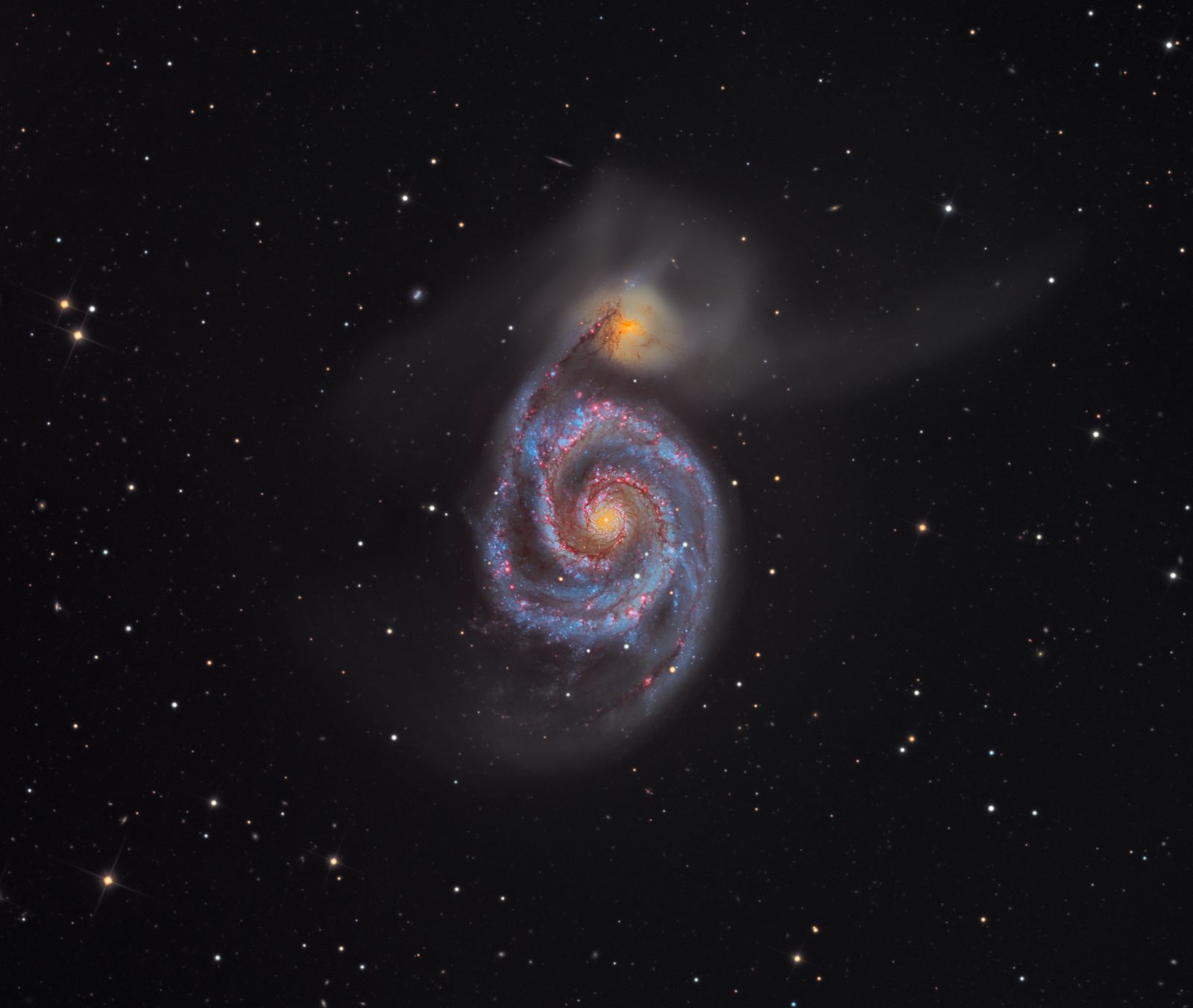When I started working with the art of astrophotography, a few people were already well-established in the field. I have referred to their work frequently, both for inspiration and as a standard that I wished to attain.
These individuals have consistently produced what I considered to be great astrophotographs because they have satisfied three important criteria.
Main Object Processing
When defending their individual processing styles, amateur astrophotographers cling to the fact that ‘art is in the eye of the beholder’. When I am processing images, I strive to achieve a natural (and calibrated) finish in as few processing steps as possible. The finished result should show no evidence of processing. Neither should it be appear to be too sharpened or too saturated. System and image calibration are fundamental to achieving this goal.
Figure 1 meets these criteria, but Figure 2 does not. As a result of an attempt to brighten the object, the colours in Figure 2 appear over-the-top and detail in the core of the galaxy is lost.


Handling the Stars
Many astrophotographs are let down by the fact that stars lack colour, are bloated, have coloured halos or appear saturated (ie. totally white). The aesthetic quality of the entire image also suffers as a result of processing artifacts: visual left-overs from the digital manipulation of an image, which include over-sharpening, over-smoothing, and unnatural saturation.
Narrowband astrophotographs are quite often spoiled because the narrowband process yields deeply induced magenta star saturation and halos that are difficult to remove. Coloured halos are a nuisance and are generally produced as the result of low optical quality or poor optical design. Halos can also be the product of the use of coloured data acquired under poor seeing. This renders some coloured star data fatter than the others, which shows up as a halo.
The bright star in Figure 3 is both saturated and bloated. This star is bright to begin with and obviated by the diffraction spikes. Figure 4 shows the star after its careful processing. The star is obviously a hot, young star and therefore blue in colour. A hint of blue has therefore been added to the core. The diffraction spikes were sharpened very slightly, the halo reduced, and the size of star itself has also been reduced. Unfortunately, all the affected stars in an image cannot be treated in this way simultaneously because of their different sizes. This means it is necessary to treat the bad stars individually to get the best result, and this can be a painstaking job when the field is full of them.


Controlling Noise
Astrophotography is more difficult than day-time photography, particularly due to the utter lack of light signal available. This is illustrated by the histograms in Figure 5 and Figure 6 (a histogram is a graphical display of the brightness values or tonal range in an image). The histogram on the left, of a day-time scene, is that of a 1/100th of a second exposure at ISO 200. The histogram on the right is that of 30 minute exposure of a deep-sky object. At the left of the histogram are the ‘black’ values, and on the right are the ‘white’ values with the remainder of the tonal range lying in between. From this, you can see that the image on the right largely consists of ‘black’ (in this case the sky background) information and not much else.


The lack of signal makes noise a major problem with astrophotography. This can be overcome by gathering enough data to improve the signal-to-noise ratio and by using processing tools to smooth out any residual noise. It is important to smooth areas of low signal-to-noise (i.e the background) and sharpen areas of high signal-to-noise (e.g. bright regions of a nebula). Many tools exist to achieve smoothing. However, too much smoothing will show up as a processing artifact. In consequence, many astrophotographers prefer to see a little ‘space noise’.
Looking again at Figure 2, the lack of attention paid to what is happening to other areas in the image during processing results in another problem. The sky background (black values, or shadows) here has become ‘clipped’ (as seen in the histogram in Figure 7). Clipping can also occur on the right side of the histogram (white values, or highlights). In either case, clipping causes the loss of detail that cannot be recovered. To prevent clipping, there should always be ‘space’ between the ‘zero’ starting position of the black point and the start of the actual histogram (Figure 8).


An astrophotographer will always say that there is ‘no right, or wrong way’ to process an image. This is a very convenient stance to take in the art of astrophotography. However, I believe that is important to attain a result that is visually pleasing, natural looking, delicately balanced in colour and in saturation. Above all, it is necessary to avoid leaving evidence behind that reveals the hours spent processing hard earned data.
Published on July 8 2013
Commissioned by Photoworks

